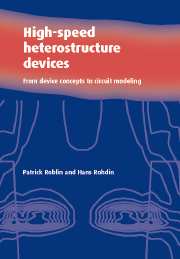Book contents
- Frontmatter
- Contents
- Preface
- Acknowledgements
- List of abbreviations
- Introduction
- 1 Heterostructure materials
- 2 Semiclassical theory of heterostructures
- 3 Quantum theory of heterostructures
- 4 Quantum heterostructure devices
- 5 Scattering processes in heterostructures
- 6 Scattering-assisted tunneling
- 7 Frequency response of quantum devices from DC to infrared
- 8 Charge control of the two-dimensional electron gas
- 9 High electric field transport
- 10 I – V model of the MODFET
- 11 Small- and large-signal AC models for the long-channel MODFET
- 12 Small- and large-signal AC models for the short-channel MODFET
- 13 DC and microwave electrothermal modeling of FETs
- 14 Analytical DC analysis of short-gate MODFETs
- 15 Small-signal AC analysis of the short-gate velocity-saturated MODFET
- 16 Gate resistance and the Schottky-barrier interface
- 17 MODFET high-frequency performance
- 18 Modeling high-performance HBTs
- 19 Practical high-frequency HBTs
- Index
4 - Quantum heterostructure devices
Published online by Cambridge University Press: 06 July 2010
- Frontmatter
- Contents
- Preface
- Acknowledgements
- List of abbreviations
- Introduction
- 1 Heterostructure materials
- 2 Semiclassical theory of heterostructures
- 3 Quantum theory of heterostructures
- 4 Quantum heterostructure devices
- 5 Scattering processes in heterostructures
- 6 Scattering-assisted tunneling
- 7 Frequency response of quantum devices from DC to infrared
- 8 Charge control of the two-dimensional electron gas
- 9 High electric field transport
- 10 I – V model of the MODFET
- 11 Small- and large-signal AC models for the long-channel MODFET
- 12 Small- and large-signal AC models for the short-channel MODFET
- 13 DC and microwave electrothermal modeling of FETs
- 14 Analytical DC analysis of short-gate MODFETs
- 15 Small-signal AC analysis of the short-gate velocity-saturated MODFET
- 16 Gate resistance and the Schottky-barrier interface
- 17 MODFET high-frequency performance
- 18 Modeling high-performance HBTs
- 19 Practical high-frequency HBTs
- Index
Summary
I cannot do it without comp[u]ters.
The Winter's Tale IV, William ShakespeareIntroduction
New devices can now be realized with thin crystalline epitaxial layers of different semiconductors. These epitaxial layers can be as thin as a few lattice parameters; where this occurs, quantum effects become dominant. In the previous chapter we developed a quantum formalism, the generalized Wannier picture, for the analysis of quantum heterostructures. In particular, this formalism was shown to account for both the periodicity in k space of the band structure and its spatial variation. Armed with these tools we shall now study a variety of quantum devices, literally taking the electrons through different aerobic exercises. We will start with the fundamental problem of an electron in a band which is accelerated by a uniform electric field. Both stationary and time-dependent states will be discussed. Next, we will study the confinement of electrons in quantum wells and the formation of a two-dimensional electron gas (2DEG). We will then place a quantum well between two barriers and study the resonant tunneling of electrons through this system. Finally, we will study the diffraction of electrons in periodic or aperiodic structures called superlattices.
Before starting we must mention that the observation of quantum effects in devices requires that the electron wave-function (here the Wannier envelope) interacts coherently within the device heterostructure. This is possible if the electron's mean free path is large compared with the main features of the device heterostructures. Usually this criterion is met for structures smaller than 200 Å. An in-depth study of the impact of scattering upon the electron wave-function will be given in Chapter 6.
- Type
- Chapter
- Information
- High-Speed Heterostructure DevicesFrom Device Concepts to Circuit Modeling, pp. 97 - 147Publisher: Cambridge University PressPrint publication year: 2002

